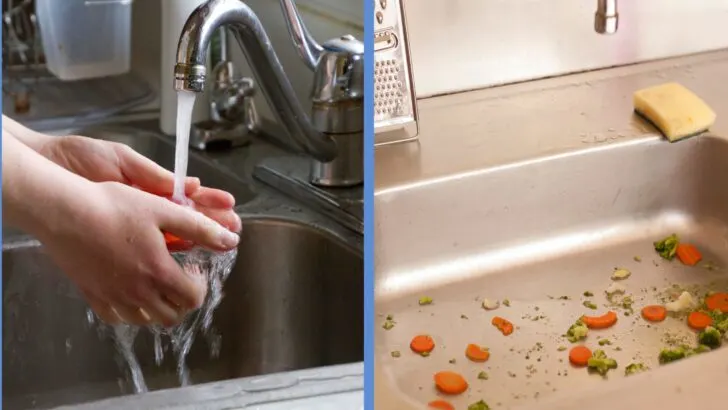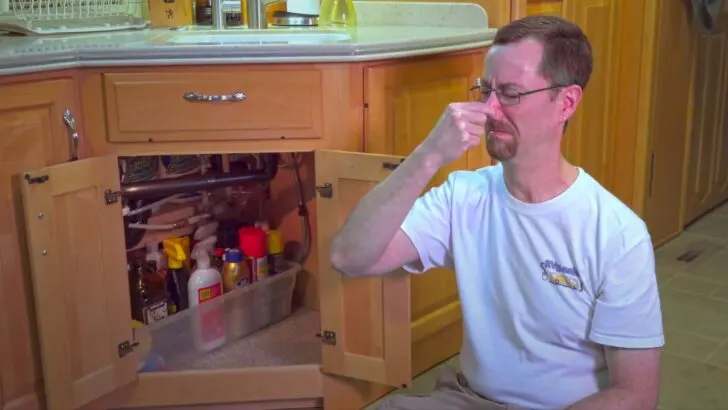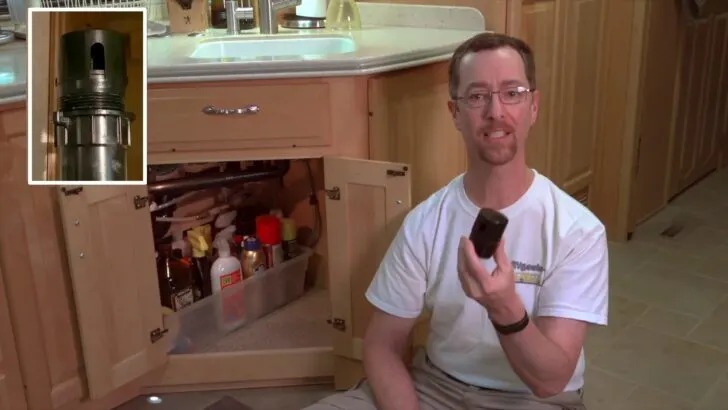Gray water is gross! And surprisingly, it can stink as much as black water! But, what exactly IS gray water in an RV and…what’s that SMELL?!!!
When a fellow RVer has an issue with a bad smell in their RV, it’s common to find them checking out their black tank or their RV toilet. Makes sense, right? But in our experience over 20 years on the road full time, we’ve found that issues related to our grey water system have more commonly been the source of any odd, really bad smells.
So, before you spend time chasing down nasty odors by focusing on your black water tank, we’d like to use this post to talk about the contents of the grey water tank and its potential for being the culprit.
With a new camping season just around the corner, let’s dive into discuss the waste water in your gray tank (or your grey tank!), and how to deal with it on your RV!
What Is Gray Water?
So, what exactly is gray water (or grey water – we’ll use both spellings throughout this post to keep everyone happy!)? Gray water is comprised of everything that goes down the drains of your RV’s showers, sinks, washing machines, and even dishwashers (we LOVE ours!).
The term “gray water” (or “grey water”) is used to describe water mixed with a whole lot of other stuff, namely, anything that runs down all the drains on your RV, with the exception of the toilet drain (anything that goes into your RV toilet runs into your black water tank and is called, you guessed it, black water).
So, grey water contains water plus any products you use in the shower or at your bathroom and kitchen sinks throughout your RV (and in your washing machine or dishwasher if your RV has one). Examples of what’s in grey water, then, are:
- various types of soap (hand, dish, laundry)
- shampoo and/or conditioner
- shaving cream
- toothpaste
- saliva
- mouthwash
- sweat
- dirt
- food particles
- milk & other beverages
- grease
- etc.
As for the route your gray water takes to get to the gray water tank, let’s use your shower as an example:
You use soap to clean yourself, shampoo to wash your hair, and guys like Peter need lots of conditioner. ???? Some of us shave in the shower using shaving cream or gel. So, whatever you use in your shower, plus the water you’re showering with, goes down your shower drain and through a pipe that leads to your gray water tank.
The same is true of everything that goes down your RV kitchen sink drain and bathroom sink drain(s). If you’ve got a washing machine on board your motorhome or travel trailer, then that’ll drain into the grey tank as well.

In addition to everything that drains from your RV shower (and washing machine if you have one), everything that runs down the drains of your RV sinks ends up in your RV gray tank.
The gray tank holds all of this (water + cleansing products you’ve used) until you’re at a dump station (or full hook-up RV site) where you can connect your sewer hose and deposit the contents of your gray tank (and black tank) into the sewer. (See our post on RV holding tank dumping for a step-by-step tutorial, video included, on the tank dumping and tank cleaning process.)
Your RV gray tank is a holding tank generally mounted underneath your rig, and almost always colored gray to identify it as the grey water tank. (Your RV’s black water tank is usually black, and most RV fresh water tanks are white.) Combined, all of the gray water drains, plumbing, and tank(s) make up your RV’s gray water system.
For further detail, please check out our post “What Is an RV Gray Water Tank?”
Why Does Gray Water Stink So Much?
As you can see from the previous section, gray water contains much more than water. But why does it stink so badly? The often-terrible smell of gray water is due to the build-up of organic matter, fat deposits, and bacteria in the tank. It’s the combination of everything that runs down your sink and shower drains.
This is one (of several) reasons why it’s generally not okay to dump your grey water on the ground (for more on this, see our post “Can You Dump Your RV Gray Water On the Ground Legally?“). Even if you’re boondocking in the middle of nowhere, if you allow the contents of your RV grey tank to drain onto the ground beneath your RV, not only will you create a horrible smell that could permeate your campsite, but you may also attract a lot of critters you didn’t intend to invite to the party. But we digress…
You may have heard of household (or business) greywater systems that harvest gray water for irrigation systems. These often pipe the drain water from household washing machines out to be used to water fruit trees or ornamental trees & plants.
But this sort of laundry-to-landscape system has limitations. Gray water can’t be recycled for use on edible crops in touch with the soil due to harmful contaminants from bacteria, grease, and detergents.
And recycled gray water has to be used within 24 hours, otherwise, the rapid breakdown of residues starts to smell… bad.
So, now that we understand why grey water itself stinks, how can it cause the atmosphere in your RV to stink?
How Can Gray Water Cause Odor In Your RV and What Can You Do About It?
If you’ve got a bad odor permeating your RV, you could have one of a couple of problems. Fortunately (or unfortunately!), we’ve dealt with both of them, so we can help you out here.
If you’ve got a nasty mystery odor in your rig, you could likely have an issue with (1) your air admittance valves, (2) your plumbing roof vents, (3) your choice of tank treatment (or lack thereof), or (4) buildup on your holding tank walls. Let’s take a quick look at each of these issues so you’ll know what to do if this happens in your rig.
Air Admittance Valves
If your under-counter air admittance valves are stuck or have failed, you’re gonna look like John did when ours failed:

If you’ve got a smell that seems to be coming from under your RV’s sink, you very well may have an air admittance valve that’s either stuck or has failed completely.
Although you may not hear or think about them often, air admittance valves are critical to plumbing systems, both in RVs and standard residential plumbing. A properly working air admittance valve allows water to flow smoothly, preventing the formation of a vacuum in the plumbing system.
Water in the p-trap of the plumbing under your sink has a purpose. It stops odors from your gray water tank from backing up into your RV through the sink drain. However, if you don’t have a working air admittance valve, a large flow of water can siphon that water out, allowing the odors from the gray tank to escape through the sink drain into your RV. And trust us… it’s NASTY!
Air admittance valves are one-way valves designed to allow air into the drain pipes, but not out of them.

Here’s John (looking happier!) with our old air admittance valve. Replacing this valve solved our problem. In the upper right-hand corner, you see a close-up of our air admittance valve.
If you’ve got a nasty odor from the cabinet under one of your sinks (although you may first smell it elsewhere… odors travel!), we suggest looking at our post entitled, “RV Holding Tank Odor Control and the Importance of Air Admittance Valves.” Not only will you find all the details about how to tell if your RV’s air admittance valve is faulty, but you’ll also find a step-by-step video tutorial on how to replace it.
Plumbing Roof Vents
Another reason you might get a nasty smell in your rig from your gray water tank is that your plumbing roof vents may not be properly channeling air/wind. When working properly, they should help to suck the odors out of the tank.
That’s why one piece of your RV’s plumbing system that’s critical to the proper functioning of the plumbing and waste tanks is your RV’s plumbing roof vent(s). Depending on how your rig is plumbed, you may have a single plumbing vent on your RV’s roof that joins the vent pipes from the black and gray tanks, or you may have two separate vent pipes.
Either way, these allow tank odors to be vented to the outside and help ensure that air can enter/exit the tanks when the volume of their contents changes (i.e. when you flush the toilet, shower, or dump the waste holding tanks).
If these vent pipes need attention, you’ll notice odors from your gray and black tanks accumulating inside the RV (it will find its way in, believe us). This makes your rig a perfectly awful place to spend time, so you’ll want to correct this issue as quickly as possible.
Traditional plumbing vent caps create no airflow whatsoever. They merely cover the vent pipes to prevent leaves and other debris from entering and clogging them. In fact, traditional vent caps can even CREATE an odor problem by directing the airflow down into the vent pipe as you’re driving, instead of up and out. So, if you notice a foul odor while driving, your vent cap may be the culprit.
We addressed this problem by replacing our vent caps with 360 Siphon vents. We switched to these vent caps back in 2014, and we haven’t had a problem since. The 360 Siphon Vent is our favorite plumbing vent cap, available in either white or black.
- Eliminates Odor - Exhausts Odors Out The Roof Vent Before They Have A Chance To Invade Your Rv
- Compatibility - Engineered For A Universal Fit, The 360 Siphon Is Compatible With All Rv Vent Caps
If you find you have a similar problem with your RV, don’t despair. Changing to a better vent cap is an easy DIY project, as long as you can access the roof of your rig. For much more on plumbing vents and the process of replacing them (step-by-step, RVgeeks style!), please see our post entitled “How to Replace an RV Plumbing Vent (and Upgrade It!)“.
Tank Treatment System
Dealing with RV holding tank odors can also be as simple as using a good tank treatment system. If you’ve already got odors coming from your holding tanks, we suggest adding a treatment to your tanks by simply putting it down the drain into an empty tank and then filling the tank with fresh water.
Let that solution soak (at least overnight), and then dump your tanks. The enzymes & bacteria in the treatment help to break down any organic waste, eliminating the odor. Thereafter, use the treatment regularly to break down waste and keep odors at bay.
Some commonly-used products on the market, such as those from Thetford and Camco, help prevent or mask odors. But after a couple of decades on the road full time, our favorite treatment overall is Happy Campers.
Not only is Happy Campers an extremely effective odor neutralizer, but it’s also cost-effective and uses a water-activated mineral blend to eliminate odors without covering them up with a perfume-like smell (gross) the way chemical deodorant treatments do.
- Powerful Odor Control: Say goodbye to unpleasant odors with our powerful formula that neutralizes and eliminates foul smells, leaving your RV smelling...
- Effective Waste Digestion: Happy Campers breaks down waste and toilet paper quickly and efficiently, preventing clogs and ensuring smooth tank...
- Super cleans RV holding tanks
- Sensors: Restore poor working sensors
RV Colonoscopy
Finally, if you’ve tried everything and can’t seem to eliminate the sewer-like odor from your rig… OR if you’ve purchased a used rig that’s been on the road before your ownership… OR if you’ve had difficulty getting your tank sensors to work properly, you may need to consider an RV colonoscopy (i.e. having your tanks professionally deep-cleaned).
We take incredibly good care of our rig, and our holding tanks are in great shape after decades on the road full time. With that said, it’s nearly impossible to stay ahead of the development of struvite on the tank walls.
When our holding tank sensors were giving us trouble and we couldn’t resolve the issue completely, we resorted to the “RV colonoscopy.” Wanna see what happened? Take a look!
Have You Had Issues With Your RV Gray Water Tank?
Drop us a comment below and let us know if you’ve had to deal with odors or other issues related to your rig’s grey water tank. Let us know how you resolved your issue.
If you haven’t been able to resolve it, we hope this post may be of help!
Free RVing Tips, Tricks, Reviews, Giveaways & More
Subscribe to our daily newsletter! We’ve been full-time RVers for 20 years (!) and share everything we’ve learned about RVing in our daily blog posts. Join our online community to receive a wealth of great RVing knowledge delivered right to your inbox.
Whether this is your first time on the road or you’re a seasoned full-timer, you’ll love the wide range of RVing topics we cover. Don’t miss a single article or any of our famous RV gear Giveaways — Subscribe today!





David Clephas
Friday 12th of April 2024
Not a smell problem per say, but seem like my grey tank doesn’t drain as fast as it should, looks like a 3” drain and maybe obstructed by something. I use Happy Camper on my 2011 MADP. Could the vent be obstructed and not allowing enough air to create a suction affect ! Thanks, love your articles
TheRVgeeks
Friday 12th of April 2024
Hi David. It's likely that the actual output from the tank is only 1.5"... but joins "downstream" with the 3" outlet from the black tank and becomes a single 3" discharge point. That said, it's certainly possible for either the vent pipe (that goes from the tank, up through the walls, and out the roof to vent gases and allow exchange of air when dumping) is clogged. The can happen because of leaves/debris... or can be the result of insect nests (like mud daubers). If that happens, then there's not enough flow to allow air down and into the tank through the vent pipe when you open the gate valve to drain it.
Another option is that there's a clot of something (large wad of toilet paper) or construction debris (sometimes the holes they cut for the tanks... the cut out part ends up IN the tank, instead of being removed... and it can lodge in the outlet, blocking flow).
If it's the former (vent pipe blocked), you could remove the cap(s) from the vent(s) on the roof and inspect... or even run some water down them to make sure they're clear (just be sure you don't run so much you fill/overflow your gray or black tanks!).
If it's the latter, you may need to visit someone like Mike at Hydro Clean AZ to have your tank(s) pressure washed to remove whatever's blocking the flow. You can see the process in our video here: https://youtu.be/2mGY63kgjh8.
Hope this helps!
Eb
Friday 14th of April 2023
I haven't really noticed any bad smells from our gray tank, but I thought an enzyme treatment would be a good thing anyway...... What do you recommend to use besides "Happy Camper" treatment to those of us that live in California? Apparently, neither one of those recommended in your article ship to Commefornia!
TheRVgeeks
Tuesday 18th of April 2023
Hi Eb... sorry 'bout that, we always forget that Happy Campers isn't available in CA (has something to do with a component used and/or HC's inability to get it tested and certified or something like that). Another product that's similar (and available in CA as far as we know) is Unique RV Digest-It. Comes in a variety of sizes and forms (liquid, powder, or pods) and is available on Amazon: https://amzn.to/3opNijb